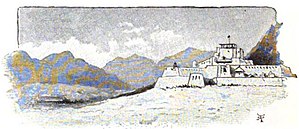The Battle of Jamrud was fought between the Emirate of Afghanistan and the Sikh Empire on 30 April 1837. The Sikhs were building up towards crossing the Khyber pass in order to invade Jalalabad. This led the Afghan National Army to confront the Sikh forces at Jamrud. The Afghan attempt to retake Peshawar from the invading Sikhs failed, but the killing of Sikh General Hari Singh Nalwa[4] limited the Khyber pass as the western extent of the Sikh Empire, which was ended about a decade later by the British.
Background[]
The Battle of Jamrud was fought between the Sikhs under Ranjit Singh and the Afghans under Emir Dost Muhammad Khan. The Afghans had been losing their long held territories to Sikhs over the preceding years due to internal conflicts, and had seen their once mighty empire shrink with the loss of the Punjab region, Multan, Kashmir, Derajat, Hazara and Peshawar. The last three now largely constitute Khyber Pakhtunkhwa. The loss of Peshawar was the most personal as the inhabitants of the region were fellow Afghans and the city was the second capital of Afghanistan.[5]
Prelude[]
Towards the end of 1836, Hari Singh Nalwa attacked and captured the small, though very strategic, fortified Misha Khel Khyberi village of Jamrud, situated on the south-side of a range of mountains at the mouth of the Khyber pass. With the conquest of Jamrud, the frontier of the Sikh Empire now bordered the frontier of Afghanistan. This Sikh victory at Jamrud was followed by the resounding defeat of the Yusafzai chief, Fatteh Khan of Panjtar.
In 1837, the Sikh army was in Lahore for Kanwar Nau Nihal Singh's wedding, (the grandson of Maharaja Ranjit Singh). It is alleged that inside information on the goings-on in Lahore were sent to Kabul by the Dogras which encouraged the Afghans to attack and attempt to reclaim Peshawar. The Emir of Afghanistan Dost Muhammad Khan immediately rushed his army accompanied by no less than five of his sons to drive the Sikhs out of Peshawar. Although the battle was not won by the Afghan army, much appreciated Sikh general Hari Singh Nalwa, was killed in the encounter.[6]
Battle[]
On taking Jamrud, Hari Singh Nalwa had asked his deputy Mahan Singh to repair the small existing fort at the entrance to the Khyber pass. Hari Singh Nalwa had simultaneously laid the foundation for a large fort in the vicinity of the smaller one, but construction activity had to cease because of the commencement of hostilities.[7]
On this occasion, Sikh forces faced the wrath of the Afghans. For want of timely help from Lahore Sardar Hari Singh Nalwa was killed by Akbar Khan, but the Afghans did not dislodge the Sikh troops from the fort. One view is that the decision to abandon the campaign to reclaim Peshawar had more to do with the logistic supply problems of the Afghan army. When Sikh reinforcements from Lahore arrived, the Afghans decided to return to Kabul.
The Afghans claimed victory,[8] though they failed to achieve their main objective. The impression which resulted from the ensuing conflict was such as to convince the men of Dost Mohammad's army of their total inability to contend with the Sikhs, but the death of Hari Singh Nalwa was a serious set back to the Sikh Forward Policy. "Even if the victory had been more decided" observed the author of the Peshawar Gazetteer sixty years later, "it would have been dearly purchased by the Sikhs, with the loss of so brave a warrior as Hari Singh"[9]
Aftermath[]
As a result of this battle, Jamrud and the Khyber pass became the western limits of Sikh influence. The loss of Hari Singh Nalwa proved a major blow to the Sikhs. In June 1839, the death of Ranjit Singh plunged the Sikh Empire into dynastic conflict. The British eventually fought two wars to defeat and dissolve the Sikh Empire.On death of sardar Hari Singh Nalwa,the Kalsa Sarkar wazir Jawahar Singh nominated Sardar General Gurmukh Singh Lamba to restore the situation and guard the gains and the Fort of Jamrud.
See also[]
- Battle of Panipat (1761)
- Battle of Attock
- Battle of Multan
- Battle of Shopian
- Battle of Nowshera
- Battle of Peshawar
- Baba Deep Singh
References[]
- ↑ Paddy Docherty (2007). The Khyber Pass: A History of Empire and Invasion. Faber and Faber. pp. 186–187. ISBN 978-1-4027-5696-2. http://books.google.com.pk/books?id=oSbovvxLlWgC&pg=PA186. Retrieved 16 August 2013.
- ↑ Maharaja Ranjit Singh: A short life sketch, Ganda Singh, Maharaja Ranjit Singh: First Death Centenary Memorial, (Nirmal Publishers, 1986), 43.[1]
- ↑ Maharaja Ranjit Singh: A short life sketch, Ganda Singh, Maharaja Ranjit Singh: First Death Centenary Memorial, 43.[2]
- ↑ http://www.harisinghnalwa.com/index.html
- ↑ The Encyclopedia of Nineteenth-century Land Warfare: An Illustrated World View, by Byron Farwell Published by W.W. Norton, 2001. ISBN 0-393-04770-9, ISBN 978-0-393-04770-7.
- ↑ Chief and families of Note in Punjab, Vol II, op.cit., pp. 87,89,90
- ↑ NAI/fpc 1-5-1837:53 quoted in Nalwa,V. 2009. Hari Singh Nalwa - Champion of the Khalsaji, New Delhi: Manohar, p. 318.
- ↑ The Sikhs and Afghans, in Connexion with India and Persia, immediately before and after the death of Ranjeet Singh: From the journal of an expedition to Kabul through the Panjab and the Khaibar Pass By Shahāmat ʻAlī, Published by J. Murray, 1847
- ↑ Gazetteer of the Peshawar District 1897-8, revised edition, Lahore: Punjab Government, p. 74.
Further reading[]
- Olaf Caroe, The Pathans
The original article can be found at Battle of Jamrud and the edit history here.
